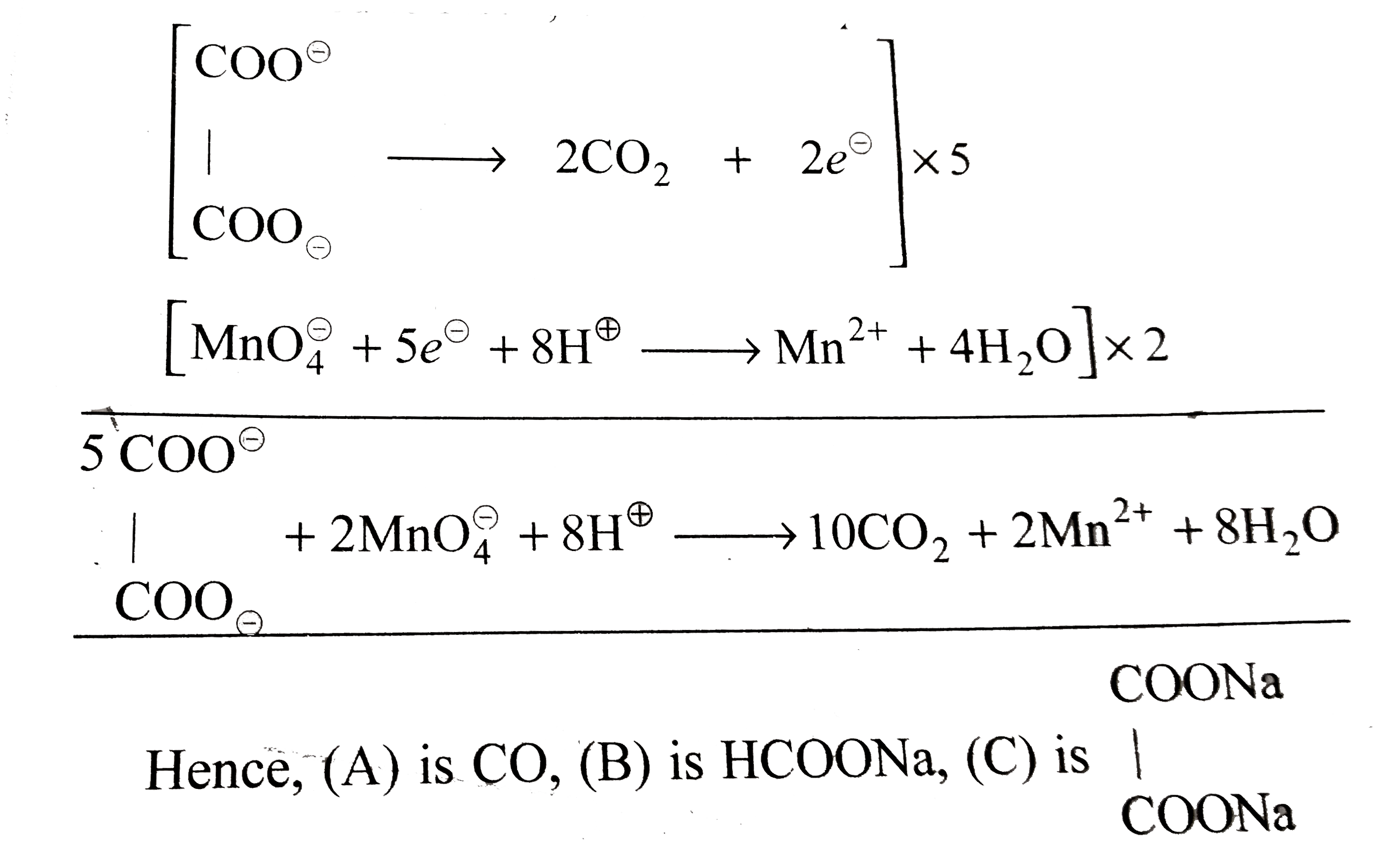When a colourless gas (A), which is poisonous and burns with blue flame, is passed through aqueous NaOH solution, gives a compound (B). Compound (B) on heating gives (C). (C) gives a white precipitate (D) with CaCl2. Both (C) and (D) decolourises KMnO4. Identify (A) to (D).
(A)Colourless,poisonousgas burns withblue flame+NaOHsoln−−−−−−−→(B)
(B) Δ−−→(C)
(C) +CaCl2→(D)White ppt.
(C) and (D) decolourise KMnO4, this indicates that both are reducing agents.
(A) is CO, i.e. carbon monoxide which burns with blue flame and is poisonous.
CO(A)+NaOH→HCOONaSodium formate(B)



Topper's Solved these Questions
- S-BLOCK GROUP 2 - ALKALINE EARTH METALSBOOK - CENGAGE CHEMISTRYCHAPTER - S-BLOCK GROUP 2 - ALKALINE EARTH METALSEXERCISE - Exercises Linked Comprehension
42 Videos
- S-BLOCK GROUP 2 - ALKALINE EARTH METALSBOOK - CENGAGE CHEMISTRYCHAPTER - S-BLOCK GROUP 2 - ALKALINE EARTH METALSEXERCISE - Exercises Multiple Correct
25 Videos
- S-BLOCK GROUP 2 - ALKALINE EARTH METALSBOOK - CENGAGE CHEMISTRYCHAPTER - S-BLOCK GROUP 2 - ALKALINE EARTH METALSEXERCISE - Ex 5.1 Objective
2 Videos
- S-BLOCK GROUP 1 - ALKALI METALSBOOK - CENGAGE CHEMISTRYCHAPTER - S-BLOCK GROUP 1 - ALKALI METALSEXERCISE - Archives Subjective
8 Videos
- SOME BASIC CONCEPTS AND MOLE CONCEPTBOOK - CENGAGE CHEMISTRYCHAPTER - SOME BASIC CONCEPTS AND MOLE CONCEPTEXERCISE - Archives Subjective
11 Videos
Similar Questions
A compound (A) is used in paints instead of salts of lead. . Compound(A) is obtained when a white compound (B) is strongly heated . Compound (B) is insoluble in water but dissolves in sodium hydroxide forming a solution of compound (C) the compounds (A) on heating with coke gives a metal (D) and a gas (E) which burns with blue flame . (B) also dissolves in ammonium sulphate solution mixed with ammonium hydroxide. solution of compound (A) in dilute HCl gives a bluish white//white precipitate (F) with excess of (F) with excees of K4[Fe(CN)6] identify (A) to (F) and explain the reactions.
View SolutionZinc on reaction with NaOH gives a salt (A) alongwith a gas (B). (A) on reaction with H2S gas gives a white precipitate (C ). Identify (A), (B) and (C ).
View Solution
Knowledge Check
Gas(A) + NaOH→BΔ−−→CΔ−−→D C and D decolourises acidified KMnO4 .Identify C and D.
ANa2CO3.NaOHB(COOH)2,(COONa)2C(COONa)2,(COOH)2DNone of theseAn aqueous solution of a salt (A) gives a white precipitate
(B) with sodium chloride solution. The filtrate gives a black precipitate
(C ) when H2S is passed into it. Compound (B) dissolves in hot water and the solution gives a yellow precipitate
(D) on treatment with sodium iodide. The compound (A) does gas on heating. Identify the compounds (A) to (D).
Compound C is :APb(NO3)2BPbCl2CPbSDPbI2An aqueous solution of a salt (A) gives a white precipitate
(B) with sodium chloride solution. The filtrate gives a black precipitate
(C ) when H2S is passed into it. Compound (B) dissolves in hot water and the solution gives a yellow precipitate
(D) on treatment with sodium iodide. The compound (A) does gas on heating. Identify the compounds (A) to (D).
Compound D is :APb(NO3)2BPbCl2CPbSDPbI2
(a) On bolining a mineral (A) with Na2CO3 solution, a white precipirtate (B) is formed.
(b) The precipitate is fitered and the filtrate contains two conpounds (C) and (D). The componds (C) is removed by crystallisation and when CO2 is passed through the mother liquor left, (D) changes to (C).
( c) On strongly heating (C), two compounds (D) and (E) are formed.
(d) (E) on heating with cobalt oxide provides blue-coloured substance (F).
Identify (A) to (F) and give chemical reaction for (a) to (d).
View Solutionalkali metal (A) on flame test gives a crimson red colour to the Busen flame. (A) on heating in air gives compound (C ) and gas (D). Gas (D) with Nessler's regent gives a brown precipitate Identify (A), (B), (C ) and (D).
View SolutionA white substance (A) reacts with dilute H2SO4 to produce a colourless suffocating gas (B) and a colourless solution (C )/ The reaction of gas (B) with potassium iodate and starch solution produce a blue colour solution. Aqueous Solution of (A) gives a white precipitate with BaCl2 solution which is soluble in dilute HCl. Addition of aqueous NH3 or NaOH to (C ) produced first a precipitate which dissolves in excess of the respective reagent to poduced a clear solution. Similarly addition of excess of potassium ferrocyanide to (C ) produced a precipitate (D) which also dissolves in aqeous NaOH giving a clear solution. Identify (A),(B),(C ) and (D ). Write the equation of the reactions involved.
View SolutionMagnesium on heating in air gives (A) and (B). On reaciton with water (B) gives a colourless gas (C).(C) when passed through CuSO4 solution, gives a blue coloured solution (D). Identify (A),(B),(C) and (D).
View SolutionAn aqueous solution of a salt (A) gives a white precipitate
(B) with sodium chloride solution. The filtrate gives a black precipitate
(C ) when H2S is passed into it. Compound (B) dissolves in hot water and the solution gives a yellow precipitate
(D) on treatment with sodium iodide. The compound (A) does gas on heating. Identify the compounds (A) to (D).
Compound B is :
View Solution
